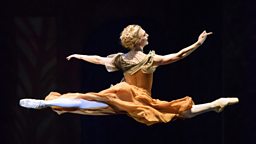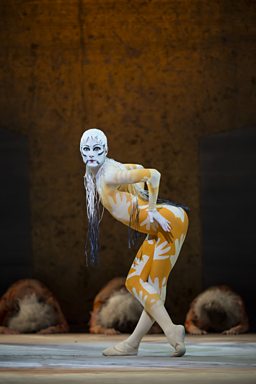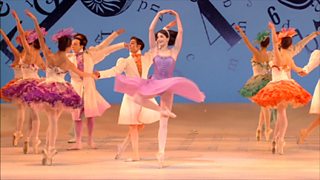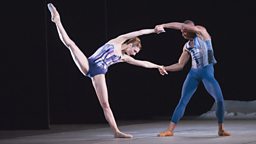Dancer's swansong: Star ballerina on heartache at end of career
4 May 2018
Zenaida Yanowsky faced down a dancer's worst nightmare – fighting back to fitness after surgery. But her struggle wasn't purely physical, the acclaimed ballerina was also coming to terms with the intense emotions sparked by reaching the end of her professional career. BBC Four's Danceworks: The Dying Swan followed her in the build-up to her final public performances.

For many professional ballet dancers, their journey begins early in childhood. So when Zenaida Yanowsky decided she wanted to become a professional at 14, her mother warned her that because of her age she faced an upward struggle. "She told me, 'You've got to work pretty hard because it's fairly late'."
As a dancer you spend most of your career polishing this really rough stone... And then you throw it into the river and you walk away.Zenaida Yanowsky
But Yanowsky put in that hard work and went on to become a prize-winning dancer. She joined the Royal Ballet in 1994 and rose up through the ranks to become one of their Principals for 16 years, receiving a clutch of awards along the way.
Despite retiring in 2017, she was determined to recover from knee surgery and bow out with a final, iconic role. "I'm thinking of the long-term future for me – not only as a dancer, but as a person. I want a knee that can walk up the mountains and can cycle. But for now, in the short term, I want a knee that can perform in a couple of months."
Those performances mark the end of a long process of continual improvement for Yanowsky.
She says: "As a dancer you spend most of your career polishing this really rough stone. You've got this beautiful stone which flickers with the slightest of light. And then you throw it into the river and you walk away."
A young Zenaida Yanowsky with her mother Carmen Robles



Yanowsky, who was raised in Spain, comes from a family of dancers. Her parents were professional dancers, as are two of her siblings.
Her mother, Carmen Robles, now runs a dance school in Gran Canaria. And it was that familiar support she sought in her battle to get back to peak fitness, as she had done previously following the birth of her children.
Yanowsky says they quickly slip back into an old pattern: "When I go back to her, I go back into that old stage – she's my teacher and I do whatever she says. She still pushes me to get better. And I'm thinking, 'Mum, I'm retiring!'
That's not to say Carmen's not proud of Yanowsky's many achievements. "She feels that I've gone beyond her achievements and expectations. A parent would like their son or daughter to stand on their shoulders and go further."
The decision to end this acclaimed career has been a tough one, Yanowsky admits. "I think what I'm going to miss is interpreting other people's lives. I will forever now be me, playing me, and not having a break from me."
But she says the physical demands of the professional dancer are harder to meet as you grow older. "It's quite hard to keep up with how you were in your thirties. It's such a hard time because you have so much more knowledge, yet your body cannot perform how you would like it to any more."
How to make it in dance
Eric Underwood, Zenaida Yanowsky and Steven McRae outline the skills needed to succeed in dance.

The three performed as soloists in the 2011 production of Alice's Adventures In Wonderland.

How did Yanowsky come to the conclusion to retire? "For me it wasn't just one moment, it was a sequence of moments. There were times when, after a performance, I wasn't that fulfilled any more. The balance between my job and my personal life wasn't quite right and I wasn't enjoying one because the other wasn't in the right place.
"I was, at points, very concerned that I wasn't being a good mother, that I wasn't present enough. I was very concerned in the future they would say, 'You never cared, your job always came first'."
For Zenaida there was really only one choice of dance to bow out with: "I think it's pretty appropriate to finish with something that is called The Dying Swan. It's a very, very small piece and to me it's like the end of a journey.
"It's a metaphor for death and end of something that is quite beautiful and ethereal and make-believe. It's the ideal end for someone's career, whose career has been to make-believe."
The appeal of The Dying Swan
Dancers continue to breathe new life into The Dying Swan into the 21st Century, such as this 2016 performance by Cira Robinson in the Thames Estuary:

The four minute routine was originally made famous by legendary Russian ballerina Anna Pavlova.
Mikhail Fokine choreographed The Dying Swan in 1905 to a piece of music called Le Cygne by Saint-Saëns. It was said to be inspired by the Tennyson poem of the same name as well as by swans in Leningrad (now called Saint Petersburg).
It became Pavlova's signature piece for rest of her life, with some estimates saying she performed the routine 4,000 times. One of her versions was captured on film in 1925.
According to legend, with her final words, Pavlova asked for her Dying Swan costume.
Mesmerising dance on BBC Four
-
![]()
Danceworks: The Dying Swan
Using the lyrical and elegant metaphor of a ballet classic about death, this film explores how a dancer fights age, the deterioration of the body over time and fear of retirement.
-
![]()
Ballet's Dark Knight: Sir Kenneth MacMillan
Exploring the life and work of celebrated yet controversial choreographer Sir Kenneth MacMillan, whose pioneering creativity changed the dance landscape forever.
-
![]()
Michael Clark's to a simple, rock 'n' roll... song
The latest work by groundbreaking choreographer Michael Clark, paying homage to three of his greatest musical influences: Patti Smith, Erik Satie and David Bowie.
-
![]()
Duet
A short film exploring the female within the world of ballet. Yasmine Naghdi and Beatriz Stix-Brunell - two of the Royal Ballet's brightest young stars - discuss and perform an all-female pas de deux.
More ballet from the BBC Arts archive
-
![]()
The Perfect Place: A 360° dance experience
BBC Arts Digital has partnered with Scottish Ballet to produce The Perfect Place - a unique dance performance using cutting-edge 360° video technology.
-
![]()
Frederick Ashton: A Genius of the Dance
He was an outsider in the world of ballet but somehow Ashton went on to become one of the founding choreographers of the Royal Ballet.
-
![]()
Rehearsal: Behind the scenes at Scottish Ballet
A revealing glimpse into the world of the professional dancer, starring Scottish Ballet's principal dancers Sophie Martin and Chris Harrison.
-
![]()
Step-by-step: Essential ballet moves
Short films demonstrating the techniques and movements of classical ballet, performed by James Hay and Yasmine Naghdi of The Royal Ballet.







